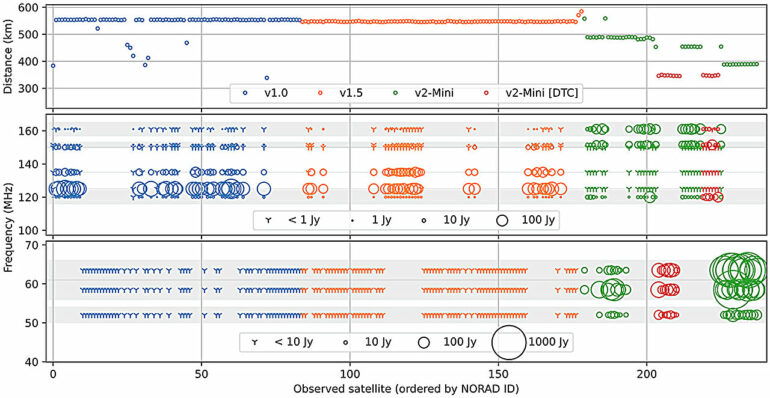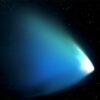Observations with the LOFAR (Low Frequency Array) radio telescope last year showed that first generation Starlink satellites emit unintended radio waves that can hinder astronomical observations.
New observations with the LOFAR radio telescope, the biggest radio telescope on Earth observing at low frequencies, have shown that the second generation V2-mini Starlink satellites emit up to 32 times brighter unintended radio waves than satellites from the previous generation, potentially blinding radio telescopes and crippling vital research of the universe.
The study is published in the journal Astronomy & Astrophysics.
In recent years, the number of satellites launched into low earth orbit (LEO) has skyrocketed, driven primarily by the rapid commercialization of space and advancements in satellite technology. Since 2019, companies like SpaceX and OneWeb have launched hundreds to thousands of satellites, particularly for communication purposes.
Plans show that the number of satellites launched into orbit could surpass 100,000 by the end of the decade. The escalation in radio wave emissions from satellites in LEO raises serious concerns for the future of astronomical research.
This study was conducted using the LOFAR radio telescope, which involved two extensive one-hour observation sessions on July 19, 2024, covering radio frequencies above and below the FM broadcast band used by radio stations that you receive with your household radio.
During these observations, the team detected unintended electromagnetic radiation (UEMR) from almost all the Starlink satellites observed, including both first-generation and second-generation satellites.
“With LOFAR we have started a program to monitor unintended emission from satellites belonging to different constellations, and our observations show that the second-generation Starlink satellites emit stronger emission and do so over a larger range of radio frequencies, compared to the first-generation satellites,” says Cees Bassa from ASTRON (the Netherlands Institute for Radio Astronomy), lead author of the study.
The analysis revealed that these newer satellites emit up to 32 times brighter unintended radio waves compared to the first generation, with levels potentially exceeding internationally regulated thresholds for interference set for intentional emissions and even more relaxed terrestrial electromagnetic compatibility standards.
“Compared to the faintest astrophysical sources that we observe with LOFAR, UEMR from Starlink satellites is 10 million times brighter. This difference is similar to the faintest stars visible to the naked eye and the brightness of the full moon. Since SpaceX is launching about 40 second-generation Starlink satellites every week, this problem is becoming increasingly worse,” adds Cees Bassa.”
This research highlights the necessity for stricter regulations surrounding satellite unintended radiation to preserve the sanctity of radio astronomical observations, which are vital for understanding the universe and our place within it. The study serves as a clarion call for action to safeguard the future of astronomy in the face of advancing satellite technology.
“Humanity is clearly approaching an inflection point where we need to take action to preserve our sky as a window to explore the universe from Earth. Satellite companies are not interested in producing this unintended radiation, so minimizing it should also be a priority in their sustainable space policies,” says Federico Di Vruno from the SKA Observatory. “Starlink is not the only big player in LEO, but they have a chance to set the standard here.”
The researchers emphasize that while the second-generation satellites have been designed to enhance connectivity and provide communication services, the unintended radio emissions are a growing threat to the integrity of astronomical observations. As the consequences of such interference become increasingly evident, collaboration between satellite companies, regulatory agencies, and the astronomical community is essential to devise effective mitigation strategies.
In the Netherlands, one of the most densely populated countries in Europe, ASTRON operates LOFAR, the most sensitive low-frequency telescope in the world. This is only possible as a result of the regulatory support of the Netherlands local, provincial and national agencies. Municipalities consult ASTRON before developments and support the institute advising others.
Prof. Jessica Dempsey, general and scientific director of ASTRON, said, “Since LOFAR began, more than a decade ago—when we were told we would soon struggle to observe because of radio interference—the regulation support and a productive collaboration with industry, totaling over 1000 individual mitigations—have been done in collaborations with dozens of groups, companies, infrastructures, agencies and individuals across the country.”
“And this relationship is not just one-sided. These clever techniques to find faint signals in the universe have returned technology advancements to industry and society—from GPS to WiFi. We don’t just co-exist, we thrive together. We have the solutions for this symbiosis in space as well—we just need the regulators to support us, and the industry to meet us half-way. Without mitigations, very soon the only constellations we will see will be human-made.”
More information:
C. G. Bassa et al, Bright unintended electromagnetic radiation from second-generation Starlink satellites, Astronomy & Astrophysics (2024). DOI: 10.1051/0004-6361/202451856
Provided by
Astronomy & Astrophysics
Citation:
Second-gen Starlink satellites leak 30 times more radio interference, threatening astronomical observations (2024, September 18)



